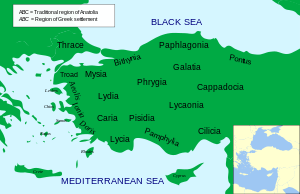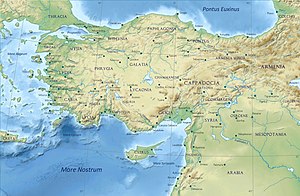Paphlagonia
| Paphlagonia (Παφλαγονία) | ||
|---|---|---|
| Ancient Region of Roman province Pontus | | |
 | ||
 | ||
Paphlagonia (
Location
The greater part of Paphlagonia is a rugged mountainous country, but it contains fertile valleys and produces a great abundance of hazelnuts and fruit – particularly plums, cherries and pears. The mountains are clothed with dense forests, notable for the quantity of boxwood that they furnish. Hence, its coasts were occupied by Greeks from an early period. Among these, the flourishing city of Sinope, founded by colonists from Miletus in ca. 630 BC, stood pre-eminent. Amastris, a few miles east of the Parthenius river, became important under the rule of the Macedonian monarchs; while Amisus, a colony of Sinope situated a short distance east of the Halys river (and therefore not strictly in Paphlagonia as defined by Strabo), grew to become almost a rival of its parent city.
The most considerable towns of the interior were
History
In the time of the Hittites, Paphlagonia was inhabited by the Kashka people, whose exact ethnic relation to the Paphlagonians is uncertain. It seems perhaps that they were related to the people of the adjoining country, Cappadocia,[clarification needed] who were speakers of one of the Anatolian branch of the Indo-European languages. Their language would appear, from Strabo's testimony, to have been distinctive.

The Paphlagonians were one of the most ancient nations of Anatolia and were listed among the allies of the Trojans in the Trojan War (ca. 1200 BC or 1250 BC), where their king Pylaemenes and his son Harpalion perished (Iliad, ii. 851–857). According to Homer and Livy, a group of Paphlagonians, called the Enetoi in Greek, were expelled from their homeland during a revolution. With a group of defeated Trojans under the leadership of the Trojan prince Antenor, they emigrated to the northern end of the Adriatic coast and later merged with indigenous Euganei, giving the name Venetia to the area they settled.

Paphlagonians were mentioned by
Under the Kingdom of Pontus
At a later period, Paphlagonia passed under the control of the Macedonian kings, and after the death of
Roman and Byzantine empires
Notable people
- Darius II
- Diogenes of Sinope (4th century BC) Greek philosopher, one of the founders of Cynicphilosophy.
- Alexander of Abonoteichus(c. 105 – c. 170 AD), also called Alexander the Paphlagonian, or the false prophet Alexander
- Saint Philaretos (8th century)
- Theodora(9th century), wife of the Byzantine emperor Theophilus
- John Mauropous (11th century), Eastern Roman poet and author
- Michael IV the Paphlagonian (c. 1010 - 1041 AD), Byzantine emperor
- Eumenes of Cardia(until he decided to leave for Troja and return to Cardia)
See also
- Ancient regions of Anatolia
- List of rulers of Paphlagonia
- Adriatic Veneti
- Kastamonu
References
- ^ Eustath. ad Horn. II. ii. 851, ad Dion. Per. 787; Steph. B. t.v.; Const. Porph. de Them. i. 7.
- ISBN 9781789697599.)
{{cite book}}: CS1 maint: multiple names: authors list (link
- Attribution
- This article incorporates text from a publication now in the public domain: Chisholm, Hugh, ed. (1911). "Paphlagonia". Encyclopædia Britannica. Vol. 20 (11th ed.). Cambridge University Press.

